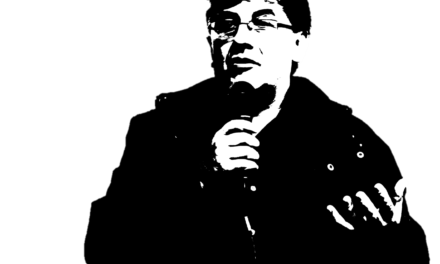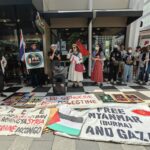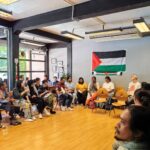By Gerard Greenfield*
Over a ten-year period, from 1961 to 1971, the US used an estimated 77 million litres of herbicides as chemical weapons for “defoliation and crop destruction” in Vietnam. Unable to control the Viet Minh’s access to food supplies or their grassroots village support, the US military response was simple: If you can’t control it, kill it. Killing food crops was both a military strategy and – with the procurement of tens of millions of litres of toxic herbicides from US chemical companies — it was also very profitable.
At least 15 different kinds of non-selective or “burn-down” herbicides were purchased from US chemical corporations and shipped to Saigon in 208-litre barrels, each marked with a 10-centimetre coloured stripe identifying its content. These coloured stripes became the code names for each toxic herbicide used as a chemical weapon. Most barrels used in the destruction of mangroves, forests, grasses, bamboo and food crops in Vietnam were marked with an orange stripe to signify they contained a mixture of 2,4-D and 2,4,5-T – what became known as Agent Orange.
Fewer in number but still significant were barrels ringed with a blue stripe, containing an arsenical herbicide (cacodylic acid) that starves plants of moisture, killing them by drying them out (dessication). (1) This was Agent Blue. By starving rice plants of moisture, the enemy (including millions of rice-growing villagers) would be starved of their most basic food. With its first recorded use on rice paddies in November 1962, over 4.7 million litres of Agent Blue were sprayed over the next nine years, forming an essential part of the US government’s “rice-killing operations”. (2) According to a new study of US military flight records that exposes far greater use of herbicides in Vietnam than previously thought: “Agent Blue was the agent of choice for crop destruction by dessication throughout the entire war, but more than four million litres of other agents, primarily containing 2,4,5-T, were also used on crops.” (3)
“MADDENINGLY” DIFFICULT TO KILL
Killing rice was a military strategy from the very start of the US aggression in Vietnam. At first, US soldiers attempted to blow up rice paddies and rice stocks, using mortars and grenades. But grains of rice are not easily destroyed and every grain that survived was a seed, to be collected and planted again. In a report to the International War Crimes Tribunal (founded by Bertrand Russell) at the end of 1967, it was stated that: “The soldiers discovered that rice is one of the most maddeningly difficult substances to destroy; using thermite metal grenades it is almost impossible to make it burn and, even if one succeeds in scattering the rice, this does not stop it being harvested by patient men. And so it is easier to use herbicides since defoliation before the rice is ripe means a 60-90 per cent loss of the harvest.” (4)
The rice-killing operations soon became more sophisticated, with rubber or plastic bladders dropped directly into rice paddies, exploding on impact and releasing toxic herbicides. Barrels of herbicides were also dropped into the water irrigating rice paddies, polluting rivers and poisoning the soil and people for the next 40 years.
Arsenical herbicides containing cacodylic acid as an active ingredient are still used today as weed-killers. In the US they are used extensively, from golf courses to backyards. They are also sprayed on cotton fields, drying out the plants before harvesting. (5) So common – and so profitable – is the original commercial form of Agent Blue that it was among 10 toxic insecticides, fungicides and herbicides partially deregulated by the US Environmental Protection Agency (EPA) in February 2004. Specific limits on toxic residues in meat, milk, poultry, and eggs were removed. (6)
Used in a less toxic formulation than Agent Blue, severe poisoning from this commercial herbicide “… causes headache, dizziness, vomiting, profuse and watery diarrhea, followed by dehydration, electrolyte imbalance, gradual fall in blood pressure, stupor, convulsions, general paralysis, and possible death within 3 to 14 days.” (7) Imagine the suffering, then, of those who were directly exposed to the bombardments of Agent Blue in rice paddies.
It is ironic that the link between the commercial products of US agro-chemical companies and the US military’s chemical weapons program contributed to the decision to end the use of Agents Orange, White, Pink, Green, Purple and Blue. As Gabriel Kolko observed: “The Nixon administration finally ended the program not because of public outcries or moral afterthoughts but because the spraying in Vietnam left insufficient herbicides for US domestic users….” (8)
Four decades later, the companies that manufactured these chemical weapons are facing a renewed public outcry. on 30 January 2004, the Vietnam Association for Agent Orange Victims (VAAOV) launched a class action lawsuit against a dozen US chemical companies in a US Federal Court in New York. (9) This includes Dow Chemical, the company responsible for the 1984 Union Carbide tragedy in Bhopal, India, that cost 20,000 lives and injured 140,000 people – a crime for which the company has not been punished for 20 years. The VAAOV lawsuit also includes the agro-chemical giant, Monsanto, which not only continues to accumulate massive profits from its herbicides, but also profits from the sale of these herbicides in Vietnam through its registered office in Ho Chi Minh City.
Monsanto is also the leading genetic engineering corporation in the world, manipulating the genetic make-up of plants to secure farmers’ dependency on its herbicide products, and locking farmers into further dependency through its patents on living organisms. And this is where we encounter yet another tragic irony in the story of the rice-killing business. Within the next three years Monsanto plans to release into the environment its genetically engineered rice varieties, targeting farmers in Asia, including Vietnam.
Not only is 2004 the year in which Vietnamese victims of Agent Orange filed an historic lawsuit against US chemical companies, it is also the United Nations’ International Year of Rice. Adopting the slogan ‘Rice is Life’, the UN’s Food and Agricultural Organization (FAO) declared that this year is “…an opportunity to celebrate and promote the ecological, social and cultural diversity of rice-based production systems as a prism through which key global concerns can be addressed.” (10) But it is an opportunity already lost. More accurately, it has been sold off. As the agency in charge of the International Year of Rice, the FAO has chosen this moment to support the genetic engineering industry. (11) No longer is there any talk of the cultural importance of rice or bio-diversity, or of the need to support ecologically and socially sustainable rice production. No longer is there talk of farmers’ rights and livelihoods. Instead, the FAO has declared its support for genetic engineering/agro-chemical giants such as Monsanto, and in doing so supports the corporate takeover of rice – the staple food of more than half the world’s population
So the International Year of Rice presents itself as an opportunity for unfinished business. Companies that were involved in the US military’s rice-killing operations are now telling us that they hold in their hands the future of rice. ‘Rice is Life’ – that is why the US government dedicated so much money and military power to killing it in Vietnam. And that is why US corporations are targeting rice today, because taking over rice means taking over life. And for those who resist this, who want to farm rice without poisoning their fields or themselves with toxic chemicals, who want to keep rice free of corporate patents, and who want to protect rice because it is life, they are faced with a new kind of battle. Because the philosophy of the powerful political and corporate elites remains unchanged: If they can’t control it, they’ll kill it.
* Gerard Greenfield is an independent researcher based in Bangkok, Thailand. [email protected]
Notes:
1. Agent Blue is a 2-663-1 mixture by weight of na-dimethyl arsenate (na cacodylate) and dimethyl arsenic (cacodylic acid).
2. Charles Mohr, ‘US Spray Destroys Rice in Vietcong Territory’, The New York Times, 21 December 1965. Two years earlier, in 1963, Richard Dudman published a series of articles in the St. Louis Post-Dispatch on the US herbicidal warfare program targeting rice fields in Vietnam.
3. Jeanne Mager Stellman, Steven D. Stellman, Richard Christian, Tracy Weber and Carrie Tomasallo, “The extent and patterns of usage of Agent Orange and other herbicides in Vietnam”, Nature, Vol. 422, 17 April 2003, p.682.
4. Edgar Lederer, ‘Report on Chemical Warfare in Vietnam’ (Second Session, 20 November-1 December 1967), Reports from the sessions of the International War Crimes Tribunal founded by Bertrand Russell, Roskilde, London, 1967-1971.
5. This includes the following products: Ansar 138, Arsan, Bolls-Eye, Broadside, Check-Mate, Cotton Aide HC, Moncide, Montar, Phytar, Phytar 138, Phytar 600, Rad-E-Cate 25, Dilic, Silvisar 510, Sylvicor.
6. EPA Federal Register, Vol. 69, No.28, 11 February 2004.
7. Extension Toxicology Network (EXTOXNET) a Pesticide Information Project of Cooperative Extension Offices at Cornell University, Michigan State University, Oregon State University and University of California at Davis.
8. Gabriel Kolko, Anatomy of a War: Vietnam, the United States and the Modern Historical Experience. New York: The New Press, 1994, p.145.
9. The lawsuit is online here: www.ffrd.org/indochina/aolawsuit.html Also see the online petition, Justice for Victims of Agent Orange: www.petitiononline.com/AOVN/petition.html
10. Record of the 17th session of the FAO Committee on Agriculture, Rome, 31 March-4 April 2003.
11. ‘FAO declares war on farmers not on hunger’, 28 May 2004: www.grain.org







